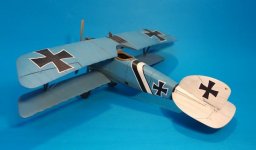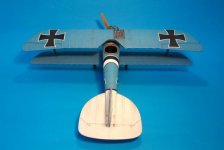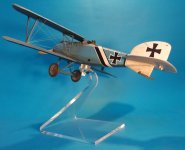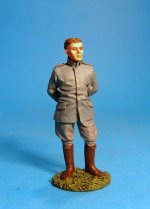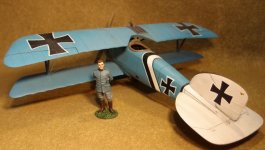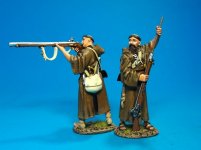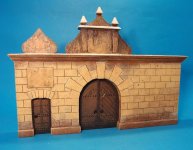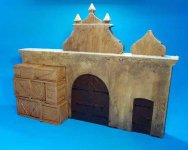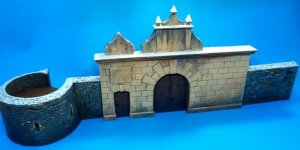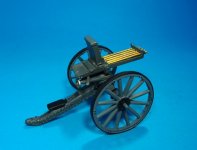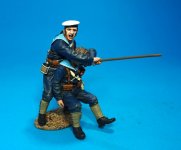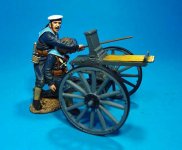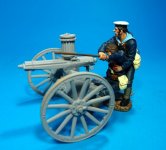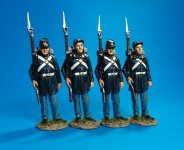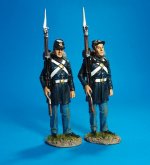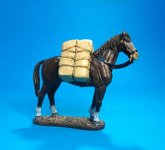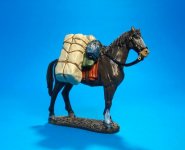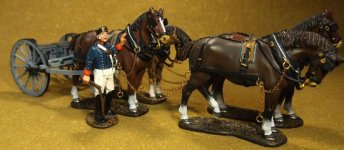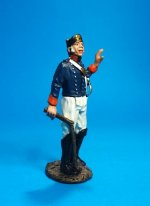Good morning, this is Part Two of the new releases for January 2013. Hope you liked Part One.
Merry Christmas and Happy New Year
Mike
Sierra Toy Soldier Company
KNIGHTS OF THE SKIES
ACE-17
Albatros DIII, “Blaue Maus” Jasta 2, March 1917
(1pcs)
Retail us$235
Hermann Frommherz (10 August 1891 - 30 December 1964) began his military career in World War I as a fighter pilot. He was credited with 32 victories.
General Major (Major General) "hard luck" Hermann Frommherz (winner of the Knight Cross and nominated for the Pour Le Merite with 32 kills) was born in the Grand Duchy of Baden in Imperial Germany in 1891, and died in Baden in the Federal Republic of Germany in 1964. A former Non-Commissioned Officer in the Jager Infantry who served with distinction on both the Eastern and Western Front before transferring to the Luftstreitkrafte (German Air Service) in the summer of 1915, Hermann Frommherz first flew two seat Aircraft, and was finally commissioned as a Leutenant in August 1916, and posted to Macedonia in late 1916. In March 1917 he was transferred to the elite Jagdstaffel (Jasta)-2 which had been commanded by the legendary Oswald Boelcke before his untimely death in 1916. Lt. Hermann Frommherz served in Jasta-2 during "Bloody April" and flew an Albatross-D-III called the "Blaue Maus" (Blue Mouse) in which he gained his first 2 kills by forcing his British opponents in a Spad-VII and BE-2c to land and be taken prisoner.
Unfortunately, his service in Jasta-2 was cut short in May 1917 when he was injured in a crash of the Blaue Maus Albatross D-III. After his recovery Lt Frommherz was reassigned as an Instructor and did not re-enter combat until May 1918 when he rejoined Jasta-2 to fly a Fokker DR-I Triplane. From June 1918 to November 1918 flying a combination of Fokker DR-I's and Fokker DR-VII's Lt. Frommherz went on a tear shooting down 30 Aircraft including 6 very formidable Bristol Fighters which he specialized in. It soon became obvious that Lt. Frommherz was not only a formidable ace, but a "born leader" and he became the very highly regarded Commanding Officer of Jasta-27, in July 1918 when Hermann Goering his life long friend was moved up. Lt. Frommherz was nominated for the Pour Le Merite (The Blue Max) in the Fall of 1918, but due to the Kaiser's abdication his award was canceled since only the Kaiser could make this award. Given the fact that Lt. Frommhertz had far exceeded the accomplishments of many other Pour Le Merite winners, the cancellation of his award was considered "hard luck". None the less "Hard Luck Hermann" was frequently seen as wearing the Pour Le Merite after the War, although it had not been officially awarded to him by the Kaiser.
Hermann Frommhertz was a Conservative Monarchist and Nationalist, but was well known to be unenthusiastic about the Nazi Party. However, as a life long friend of Hermann Goering with very strong leadership skills he initially benefited from the rise of the Nazi Party, and became first a Colonel and then a Major General in the Luftwaffe in the 1930's and during the early part of World War-II. He was heavily involved in the occupation of Czechoslovakia, but after that his lack of enthusiasm for the Nazi cause seems to have cost him, and he was regulated to secondary commands during World War-II and eventually placed on the retirement list. After the war he was briefly detained by the French and then went home to his beloved Baden.
ACE-17P
Ltn. Hermann Frommherz “Hard Luck Hermann”
(1pcs)
Retail us$37
Ernst Udet (26 April 1896 – 17 November 1941) was the second-highest scoring German flying ace of World War I. He was one of the youngest aces and was the highest scoring German ace to survive the war (at the age of 22). His 62 victories were second only to Manfred von Richthofen, his commander in the Flying Circus. Udet rose to become a squadron commander under Richthofen, and later, under Hermann Göring.
Udet spent the 1920s and early 1930s as a stunt pilot, light aircraft manufacturer, and playboy. In 1933, he joined the Nazi Party and became involved in the early development of the Luftwaffe. He used his networking skills to be appointed as director of research and development for the air force. He was especially influential in adoption of dive bombing techniques and the development of the Stuka dive bomber. By 1939, Udet had risen to the post of Director-General of Equipment for the Luftwaffe.
Udet had the letters “LO” painted on the side of his aircraft. This was an abreviation for his fiances nickname “Lola’, Eleanore Zink.
He married "Lo" on February 25, 1920; however, the marriage lasted less than three years. They divorced on February 16, 1923. It has been said that Udet had many lovers.
ACE-15P
Udet and Lola
(3pcs)
Retail us$79
THE PENINSULAR WAR 1807-1814
Many priests, friars and monks joined guerilla bands and a few were even known to become leaders. El Cura, a parish priest probably being the most famous, Valdes was a Spanish friar who was an extraordinary marksman, and accounted for an incredible number of French soldiers.
PSG-05
Two Monks Loading and Firing,
(2pcs)
Retail us$78
THE SEVEN YEARS WAR
This month includes the release of the first of 3 scenic items for the Battle of Leuthen Series. The Circular turret and straight wall items will be available in March.
LEUT-10
THE BATTLE OF LEUTHEN 1757, LEUTHEN CHURCHYARD GATEWAY,
(3pcs)
Retail us$138
Model Size 12 ¼” x 8 ½” x 2 ½”
Rear View of Gateway
THE FIRST SUDAN WAR 1884-1885
William Gardner patented his 5-barrel machine gun, in August 1881. Unfortunately the United States Army was firmly wedded to the Gatling gun at that time, and showed little interest, so Gardner manufactured this gun in the UK, selling mostly to the Royal Navy, who appreciated its lighter weight, compared to the Gatling. The 5-barrel gun fired a .45 inch bullet at up to 812 rounds per minute, and was sighted out to 2,000 yards.
During tests by the British army, the five-barrelled Gardner gun fired 16,754 rounds before a failure occurred, with only 24 stoppages. When operator-induced errors were taken into account, there were only 4 malfunctions in 10,000 rounds fired. The Army adopted the weapon, although its introduction was delayed because of opposition from the Royal Artillery.
It saw action in the Sudan, notably at the Battle of Abu Klea, where unfortunately its mechanism proved vulnerable to the environmental conditions of loose sand and dust.
SRNGUN-02
5 BARRELLED GARDNER GUN,
(3pcs)
Retail us$45
This the newest Naval Brigade set, and is designed to be a stand-alone casualty set, or can be used both with the Gardner (SRNGUN-02) and the Gatling Gun (SRNGUN-01).
**PLEASE NOTE, Unfortunately the SRN-01 seated figure does not work well with the Gardner Gun, as his hand does not touch the firing handle.**
SRN-07
British Naval Brigade, Wounded Sailor and Helper,
(2pcs)
Retail us$78
THE AMERICAN CIVIL WAR 1861-1865
The Marine Corps were to play a moderate role in the American Civil War (1861–1865) and were basically overshadowed by the confrontations of the land forces. Their most prominent task was blockade duty, and the strategic significance of the Federal blockade of southern ports, and the struggle for the Mississippi River were of real importance.
A battalion of Marines was to take part in the First Battle of Bull Run (First Manassas)
As more and more states seceded from the Union, about half of the Corps' officers left the Union to join the Confederacy and form the Confederate States Marine Corps, which ultimately played little part in the war.
ACWM-01
U.S. MARINES 1861-1865, 2 Figures standing,
(2pcs)
Retail us$64
PLEASE NOTE THE ACW-01N SET CONTAINS THE SAME TWO FIGURES AS ACWM-01
ACWM-01N
UNION MARINE CORPS, 4 Figures standing,
(4pcs)
Retail us$116
THE BATTLE ON THE MONONGAHELA 1755
Packs are separate from the horses, and are interchangeable.
BAL-08A
PACK HORSE #3
(2pcs)
Retail us$48
BAL-08B
PACK HORSE #4
(2pcs)
Retail us$48
THE BATTLE OF CHIPPEWA July 5th 1814
At the start of the Napoleonic period the foot artillery still hired civilian drivers. This proved unsatisfactory and in 1806 the “Corps of Royal Artillery Drivers” was established.
They became known by their knickname the “Wee Gee Corps”
This was a separate corps to the rest of the foot artillery, and it was only the horse artillery that had their own drivers.
BCHLIMB-05
BRITISH CORPS OF ARTILLERY DRIVERS ,
(1pc)
Retail us$32
Once again hope you like this superb set of releases as much as I do. Lots of pictures to come.
Best regards
Mike
Sierra Toy Soldier Company
Merry Christmas and Happy New Year
Mike
Sierra Toy Soldier Company
KNIGHTS OF THE SKIES
ACE-17
Albatros DIII, “Blaue Maus” Jasta 2, March 1917
(1pcs)
Retail us$235
Hermann Frommherz (10 August 1891 - 30 December 1964) began his military career in World War I as a fighter pilot. He was credited with 32 victories.
General Major (Major General) "hard luck" Hermann Frommherz (winner of the Knight Cross and nominated for the Pour Le Merite with 32 kills) was born in the Grand Duchy of Baden in Imperial Germany in 1891, and died in Baden in the Federal Republic of Germany in 1964. A former Non-Commissioned Officer in the Jager Infantry who served with distinction on both the Eastern and Western Front before transferring to the Luftstreitkrafte (German Air Service) in the summer of 1915, Hermann Frommherz first flew two seat Aircraft, and was finally commissioned as a Leutenant in August 1916, and posted to Macedonia in late 1916. In March 1917 he was transferred to the elite Jagdstaffel (Jasta)-2 which had been commanded by the legendary Oswald Boelcke before his untimely death in 1916. Lt. Hermann Frommherz served in Jasta-2 during "Bloody April" and flew an Albatross-D-III called the "Blaue Maus" (Blue Mouse) in which he gained his first 2 kills by forcing his British opponents in a Spad-VII and BE-2c to land and be taken prisoner.
Unfortunately, his service in Jasta-2 was cut short in May 1917 when he was injured in a crash of the Blaue Maus Albatross D-III. After his recovery Lt Frommherz was reassigned as an Instructor and did not re-enter combat until May 1918 when he rejoined Jasta-2 to fly a Fokker DR-I Triplane. From June 1918 to November 1918 flying a combination of Fokker DR-I's and Fokker DR-VII's Lt. Frommherz went on a tear shooting down 30 Aircraft including 6 very formidable Bristol Fighters which he specialized in. It soon became obvious that Lt. Frommherz was not only a formidable ace, but a "born leader" and he became the very highly regarded Commanding Officer of Jasta-27, in July 1918 when Hermann Goering his life long friend was moved up. Lt. Frommherz was nominated for the Pour Le Merite (The Blue Max) in the Fall of 1918, but due to the Kaiser's abdication his award was canceled since only the Kaiser could make this award. Given the fact that Lt. Frommhertz had far exceeded the accomplishments of many other Pour Le Merite winners, the cancellation of his award was considered "hard luck". None the less "Hard Luck Hermann" was frequently seen as wearing the Pour Le Merite after the War, although it had not been officially awarded to him by the Kaiser.
Hermann Frommhertz was a Conservative Monarchist and Nationalist, but was well known to be unenthusiastic about the Nazi Party. However, as a life long friend of Hermann Goering with very strong leadership skills he initially benefited from the rise of the Nazi Party, and became first a Colonel and then a Major General in the Luftwaffe in the 1930's and during the early part of World War-II. He was heavily involved in the occupation of Czechoslovakia, but after that his lack of enthusiasm for the Nazi cause seems to have cost him, and he was regulated to secondary commands during World War-II and eventually placed on the retirement list. After the war he was briefly detained by the French and then went home to his beloved Baden.
ACE-17P
Ltn. Hermann Frommherz “Hard Luck Hermann”
(1pcs)
Retail us$37
Ernst Udet (26 April 1896 – 17 November 1941) was the second-highest scoring German flying ace of World War I. He was one of the youngest aces and was the highest scoring German ace to survive the war (at the age of 22). His 62 victories were second only to Manfred von Richthofen, his commander in the Flying Circus. Udet rose to become a squadron commander under Richthofen, and later, under Hermann Göring.
Udet spent the 1920s and early 1930s as a stunt pilot, light aircraft manufacturer, and playboy. In 1933, he joined the Nazi Party and became involved in the early development of the Luftwaffe. He used his networking skills to be appointed as director of research and development for the air force. He was especially influential in adoption of dive bombing techniques and the development of the Stuka dive bomber. By 1939, Udet had risen to the post of Director-General of Equipment for the Luftwaffe.
Udet had the letters “LO” painted on the side of his aircraft. This was an abreviation for his fiances nickname “Lola’, Eleanore Zink.
He married "Lo" on February 25, 1920; however, the marriage lasted less than three years. They divorced on February 16, 1923. It has been said that Udet had many lovers.
ACE-15P
Udet and Lola
(3pcs)
Retail us$79
THE PENINSULAR WAR 1807-1814
Many priests, friars and monks joined guerilla bands and a few were even known to become leaders. El Cura, a parish priest probably being the most famous, Valdes was a Spanish friar who was an extraordinary marksman, and accounted for an incredible number of French soldiers.
PSG-05
Two Monks Loading and Firing,
(2pcs)
Retail us$78
THE SEVEN YEARS WAR
This month includes the release of the first of 3 scenic items for the Battle of Leuthen Series. The Circular turret and straight wall items will be available in March.
LEUT-10
THE BATTLE OF LEUTHEN 1757, LEUTHEN CHURCHYARD GATEWAY,
(3pcs)
Retail us$138
Model Size 12 ¼” x 8 ½” x 2 ½”
Rear View of Gateway
THE FIRST SUDAN WAR 1884-1885
William Gardner patented his 5-barrel machine gun, in August 1881. Unfortunately the United States Army was firmly wedded to the Gatling gun at that time, and showed little interest, so Gardner manufactured this gun in the UK, selling mostly to the Royal Navy, who appreciated its lighter weight, compared to the Gatling. The 5-barrel gun fired a .45 inch bullet at up to 812 rounds per minute, and was sighted out to 2,000 yards.
During tests by the British army, the five-barrelled Gardner gun fired 16,754 rounds before a failure occurred, with only 24 stoppages. When operator-induced errors were taken into account, there were only 4 malfunctions in 10,000 rounds fired. The Army adopted the weapon, although its introduction was delayed because of opposition from the Royal Artillery.
It saw action in the Sudan, notably at the Battle of Abu Klea, where unfortunately its mechanism proved vulnerable to the environmental conditions of loose sand and dust.
SRNGUN-02
5 BARRELLED GARDNER GUN,
(3pcs)
Retail us$45
This the newest Naval Brigade set, and is designed to be a stand-alone casualty set, or can be used both with the Gardner (SRNGUN-02) and the Gatling Gun (SRNGUN-01).
**PLEASE NOTE, Unfortunately the SRN-01 seated figure does not work well with the Gardner Gun, as his hand does not touch the firing handle.**
SRN-07
British Naval Brigade, Wounded Sailor and Helper,
(2pcs)
Retail us$78
THE AMERICAN CIVIL WAR 1861-1865
The Marine Corps were to play a moderate role in the American Civil War (1861–1865) and were basically overshadowed by the confrontations of the land forces. Their most prominent task was blockade duty, and the strategic significance of the Federal blockade of southern ports, and the struggle for the Mississippi River were of real importance.
A battalion of Marines was to take part in the First Battle of Bull Run (First Manassas)
As more and more states seceded from the Union, about half of the Corps' officers left the Union to join the Confederacy and form the Confederate States Marine Corps, which ultimately played little part in the war.
ACWM-01
U.S. MARINES 1861-1865, 2 Figures standing,
(2pcs)
Retail us$64
PLEASE NOTE THE ACW-01N SET CONTAINS THE SAME TWO FIGURES AS ACWM-01
ACWM-01N
UNION MARINE CORPS, 4 Figures standing,
(4pcs)
Retail us$116
THE BATTLE ON THE MONONGAHELA 1755
Packs are separate from the horses, and are interchangeable.
BAL-08A
PACK HORSE #3
(2pcs)
Retail us$48
BAL-08B
PACK HORSE #4
(2pcs)
Retail us$48
THE BATTLE OF CHIPPEWA July 5th 1814
At the start of the Napoleonic period the foot artillery still hired civilian drivers. This proved unsatisfactory and in 1806 the “Corps of Royal Artillery Drivers” was established.
They became known by their knickname the “Wee Gee Corps”
This was a separate corps to the rest of the foot artillery, and it was only the horse artillery that had their own drivers.
BCHLIMB-05
BRITISH CORPS OF ARTILLERY DRIVERS ,
(1pc)
Retail us$32
Once again hope you like this superb set of releases as much as I do. Lots of pictures to come.
Best regards
Mike
Sierra Toy Soldier Company
Attachments
Last edited:


